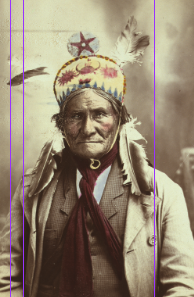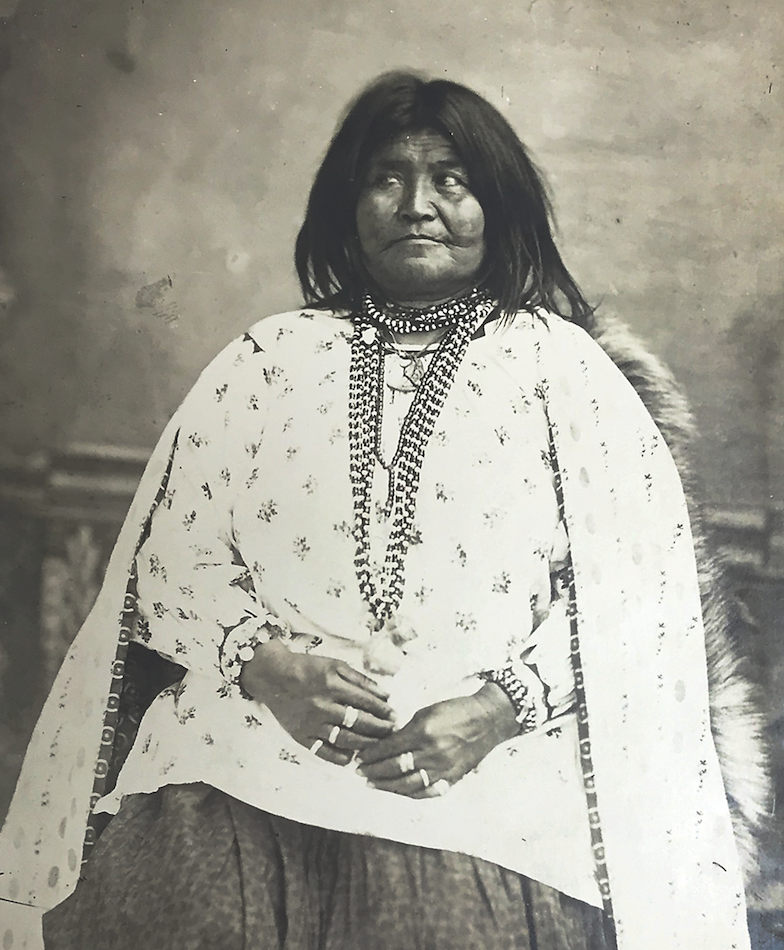Apache oral tradition records several brave women, such as Lozen, sister of Chihenne Chief Victorio, who reportedly participated in Chiricahua raids in the 1870s and ’80s.
Not as well known but certainly courageous in her own right was Huera, or Tze-gu-juni (her Chihenne name, meaning “Pretty Mouth”). She was not a combatant, but her second husband, the Bedonkohe Apache warrior Geronimo, called her “the bravest of Apache women.”
Little is known of Huera’s youth. She was born circa 1847. During a fierce thunderstorm lightning struck her, her mother and her sister, and only Tze-gu-juni survived. She was in her early 30s on Oct. 14, 1880, when a Mexican ambush claimed the lives of Victorio, other Chihennes and their Mescalero Apache allies at Tres Castillos, Chihuahua, Mexico.
ENSLAVED IN MEXICO
The Mexicans captured Tze-gu-juni and nearly 70 other Apache women and children, sending them to Mexico City as slaves. Her Mexican owners called Tze-gu-juni Francesca (Frances), or Huera, a corruption of guera, Spanish slang for a fair-skinned or fair-haired female. Though neither, Huera must have seemed fairer than other captured Apache women. While in captivity she learned Spanish fluently, allowing her to later serve as a translator at the San Carlos Apache Indian Reservation in Arizona Territory.
After four or five years in forced servitude she and several others escaped their hacienda prison near Mexico City with only one knife and one blanket among them. Ahead of them lay a daunting trek of some 1,300 miles. They survived the Chihuahuan Desert by eating the tuna, or fruit, of prickly pear cacti and other wild foods.
En route a mountain lion attacked Huera, seeking a quick kill by going for her throat. She managed to tighten a blanket around her neck for protection, but the cougar tore at her scalp, parting it from her skull. Still she fought on, eventually plunging a knife into the animal’s heart.
GET HISTORY’S GREATEST TALES—RIGHT IN YOUR INBOX
Subscribe to our HistoryNet Now! newsletter for the best of the past, delivered every Monday and Thursday.
The mountain lion was dead, but Huera was in bad shape. The other women reattached her scalp with thorns and used the cougar’s own sputum to help heal her wounds. Resting only briefly, Huera soon resumed the slog north with the others. After several months the weary travelers finally reached San Carlos, shocking family and friends with their fortitude.
The scars on Huera’s chest, hands and face from the cougar mauling remained with her the rest of her life. She seemed both brave and charmed to have survived such an ordeal.
EXPERT TISWIN MAKER
Once back at San Carlos she interpreted for the U.S. Army, became a mother figure to many young Apache women and served her people as a shaman. She also became an expert maker of tiswin, a fermented alcoholic beverage brewed from corn and in high demand on the reservations.
She had learned the skill while a slave in Mexico. Authorities at San Carlos discouraged its use, as Apache males who consumed great quantities of it became unruly or lazy and sometimes abusive to their women and children. Regardless, the Apaches resisted any interference with its production or consumption.
On May 16, 1885, at San Carlos, Geronimo made a decision based partly on fear of being seized and executed, partly on tiswin intoxication, and partly on a rousing speech by Huera, who was then married to Mangas (son of famed Apache leader Mangas Coloradas).

“If you are old women and children, you will stay here and wait to receive your punishment,” she said. “But if you are warriors you will take the warpath and the Gray Fox [Brig. Gen. George Crook] must catch you before you are punished. Maybe so you go to Sonora, and he no catch you. I have spoken.”
The next day Geronimo, Mangas and some 145 other Apaches bolted from the reservation, joined within a few days by Chihuahua and Naiche. Soon following in pursuit were some 5,000 U.S. Army troops. “In analyzing this pivotal moment in Chiricahua history,” writes historian Edwin R. Sweeney in From Cochise to Geronimo, “we should not underestimate the influence of Huera.”
HELD HOSTAGE BY SOLDIERS
The renegade warrior leaders probably brought their families with them. Later that year, however, soldiers captured Huera and many of the other wives and children in raids and held them hostage—first at Fort Apache and later Fort Bowie. Authorities hoped their captivity would convince the renegade warriors to surrender.
In March 1886 Geronimo and others did promise to surrender to Crook at Cañon de los Embudos (Canyon of the Funnels) in the Sierra Madre of Sonora. But as they approached the Arizona Territory border, Geronimo, Naiche and some 40 followers bolted, and only Chihuahua and his band came in. Not until September 4 did Geronimo and Naiche also surrender, to Brig. Gen. Nelson Miles at Skeleton Canyon, Arizona Territory.
The government shipped not only Geronimo and the other renegade Apaches to Florida as prisoners of war, but also the Apache scouts who had worked for the Army, as well as most of the remaining San Carlos Chiricahuas, including the brave Huera, Lozen and Dahteste (said to be a female warrior like Lozen).
Their POW status was supposed to last two years but stretched to a quarter-century for many, unless they first died from malnutrition or disease. The death rate at Fort Marion was especially high among children and the elderly, and Huera sang dirges, much appreciated by the other mournful prisoners. She also served in a religious role as a shaman.
BURIED BESIDE EACH OTHER
Geronimo, Huera and the others were ultimately transferred to Fort Sill, Indian Territory (present-day Oklahoma), and he later took her as one of his many wives. The date of Huera’s death is uncertain. Some say she died in 1892. Author Peter Aleshire contends it was sometime after 1894. Other sources claim she died at Fort Sill in 1901 or ’02, when she was about 54.
Geronimo himself died at age 79 in 1909. The Chiricahua chief and his bravest of wives lie alongside one another in the Beef Creek Apache Cemetery at Fort Sill.
John P. McWilliams recently published a second edition of his book Against the Wind: Courageous Apache Women, which profiles Lozen, Huera and four other Apache heroines. He gives regular talks about them in New Mexico.
An earlier version of this story appeared in the June 2017 print edition of Wild West.
historynet magazines
Our 9 best-selling history titles feature in-depth storytelling and iconic imagery to engage and inform on the people, the wars, and the events that shaped America and the world.






